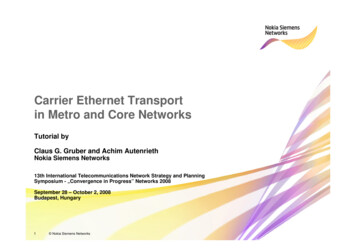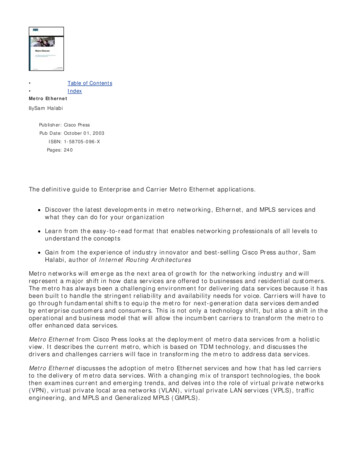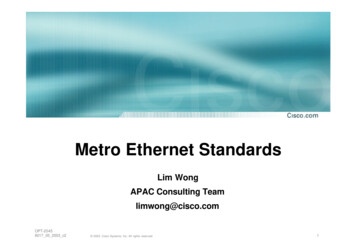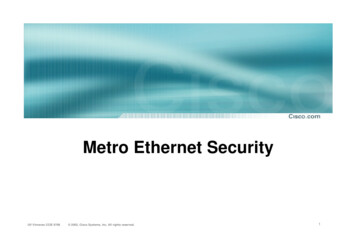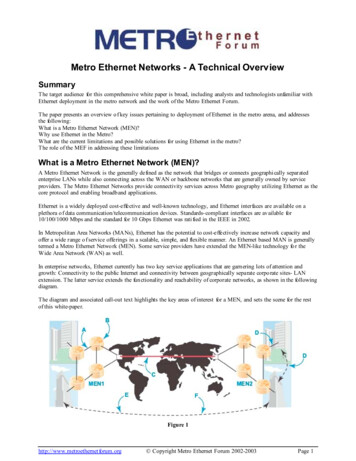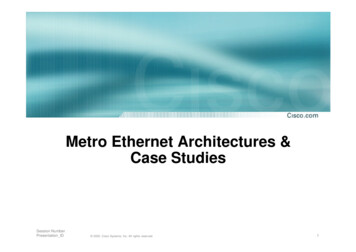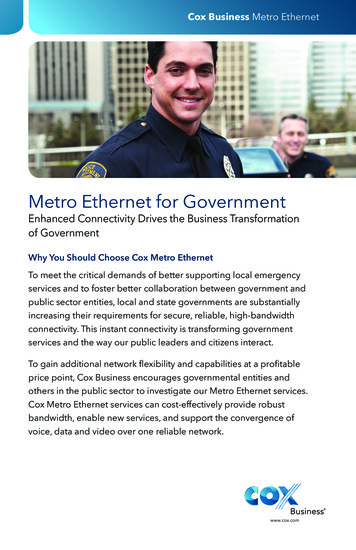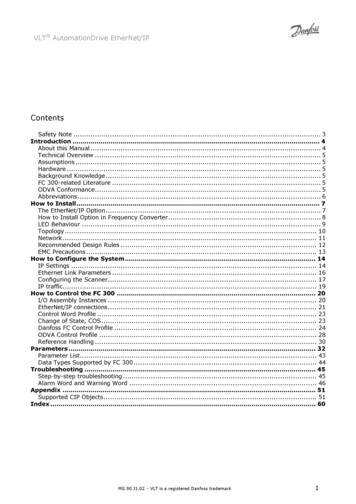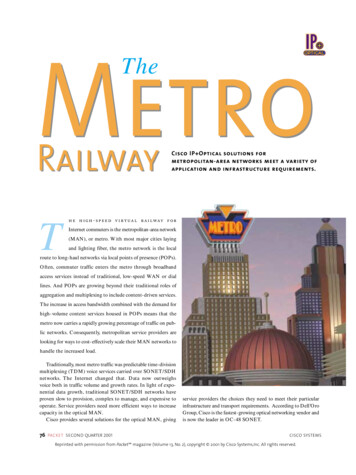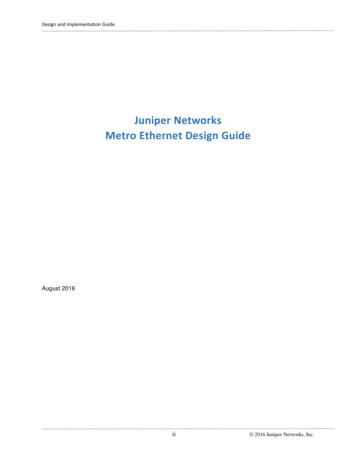
Transcription
Design and Implementation GuideJuniper NetworksMetro Ethernet Design GuideAugust 2016ii 2016 Juniper Networks, Inc.
Design and Implementation GuideJuniper Networks, Inc.1133 Innovation WaySunnyvale, California 94089USA408-745-2000www.juniper.netCopyright 2016, Juniper Networks, Inc. All rights reserved. 2016 Juniper Networks, Inc.iii
Design and Implementation GuideTable of ContentsChapter 1Introduction . 1Using MPLS with Metro Ethernet . 1Metro Ethernet Solutions . 2Chapter 2Metro Ethernet Overview . 3Metro Ethernet Service Types . 5Carrier Ethernet Overview. 5Carrier Ethernet Certification . 6Chapter 3Architecture Overview . 7Juniper Networks Portfolio for Metro Ethernet Networks . 7ACX Series Routers in the Access Segment . 7ACX Series Routers in the Metro Aggregation Segment . 7MX Series Routers in the Metro Aggregation and Core Segments . 8PTX Series Routers in the Core Segment . 8Junos Space Platform . 8Metro Ethernet as Part of Access and Aggregation . 9Ethernet Bridging as Metro Ethernet Transport . 10Chapter 4Metro Ethernet Scenarios . 13Layer 2 Business Access . 13Wholesale Mobile Backhaul . 15Wholesale MBH Deployment Options . 17Wholesale MBH Deployment with Dual E-Line Services and Layer 3 CPE . 18Wholesale MBH Deployment with Dual E-Line Services and Layer 2 CPE . 19Wholesale MBH Deployment with E-LAN/E-Tree Services . 20Layer 3 Business Access and DIA Service Profile. 22Residential Aggregation Use Case . 25Enabling EVC for Residential Internet Access . 26iv 2016 Juniper Networks, Inc.
Design and Implementation GuideEnabling Multicast Delivery in the MAN . 29Enabling Connectivity for the Inbound OAM of the CPE/STB. 33Chapter 5Enabling Metro Ethernet Services on Junos Platforms. 35Design Considerations, Definitions, and Prerequisites . 35Deployment Topologies . 36Chapter 6Metro Ethernet Nodes and Functions . 39Metro Access Nodes and Functions . 39Metro Aggregation Nodes and Functions . 40Chapter 7Enabling Metro EVC in Junos . 43Establishing End-to-End EVCs . 47S-VLAN Translation of the EVC between Ethernet Rings . 48Ethernet Bridging verses MPLS in the Access Node. 50Specifics of VPLS Deployments in the MAN . 51BGP Versus LDP Signaling . 51End-to-End EVC Stitching with VPLS Routing Instance (Option 1). 52End-to-End EVC Stitching with VPLS RI (Option 2) . 54Recommendations for VPLS Routing Instances and VSI Deployment in the MAN . 56Summary of the VPLS Flavors Supported by Junos Platforms . 57MPLS AN with Multiple UNIs per Customer . 58Using LT-Interface at VPLS Hub to Terminate Spoke’s PW. 59VPLS Light Deployment Options on ACX Series Routers . 60Terminating Multiple Spokes from a Single AN into the Same Mesh Group . 60 2016 Juniper Networks, Inc.v
Design and Implementation GuideChapter 8Tunneling L2CP Traffic . 63MX Series Router as VPLS or MPLS Access Node . 65ACX Router as Ethernet Access Node . 65ACX Router as MPLS Access Node . 65Chapter 9CoS Planning for Metro Ethernet Services . 67General Notes about CoS Management on Junos Platforms . 67Customer Frame Classification and Scheduling in MAN. 70Customer L2CP Frames Classification . 73Chapter 10Bandwidth Profile for Metro-E Services . 75Defining Bandwidth Profile . 75Coupling Flag and Color Mode Consideration. 76Bandwidth parameters: CIR, EIR, CBS and EBS . 77Supported BWP Models and Platforms . 78Chapter 11Infrastructure Security Design and Considerations . 79Security Considerations . 79Protecting Against Unauthorized Access . 80Protecting Against Hijacking Threats . 80Control Plane DDOS Protection . 80CFM Traffic Policing . 81Restricting the Size of MAC Learning Tables . 81Protecting Against Layer 2 Loops . 81Infrastructure Triggered Broadcast Storms . 82Broadcast Storms in VPLS Architectures . 82Broadcast Storms in a Hybrid Architectures . 82vi 2016 Juniper Networks, Inc.
Design and Implementation GuideCustomer-Triggered Broadcast Storms . 82Layer 2 Storm Control. 84Control Plane Protection During a Layer 2 Storm . 85MAC Move Control . 85Chapter 12Providing Resiliency in Metro Ethernet Networks . 87Resilient Metro Ethernet Networks . 87Pseudowire Redundancy for T-LDP PW . 87Protecting Dual-homed CPE with MC-LAG . 90Chapter 13Protection with IEEE G.8032 Protocol . 93Using G.8032 for Native Ethernet Access Segments . 93Using G.8032 with Ethernet-to-VPLS Stitching . 94Remote End Failure Detection Signaling via LFM . 95Pseudowire Tail-end Protection for Metro PE to PE Failure . 97Chapter 14OAM . 99Ethernet OAM . 100Intra-segment OAM . 102Intersegment OAM . 103Chapter 15Inventory of the Network Services . 105Chapter 16Deployment Scenarios and Recommendations . 109Deployment Scenarios . 109EP-LINE Deployment Scenarios . 110EP-LINE with a Native Ethernet Segment . 111EP-LINE with End-to-End MPLS PW. 113EP-LINE with Ethernet to MPLS PW Stitching . 115EP-LINE with Ethernet to VPLS Termination . 117EVP-LINE Deployment Scenarios . 119EVP-LINE within a Native Ethernet Segment . 120EVP-LINE with End-to-End MPLS PW. 122 2016 Juniper Networks, Inc.vii
Design and Implementation GuideEVP-LINE with Ethernet to MPLS PW Stitching . 124EVP-LINE with Carrier Ethernet to VPLS Termination . 126EP-LAN Deployment Scenarios . 128EP-LAN within a Native Ethernet Segment . 128EP-LAN with MPLS PW to VPLS Termination . 130EP-LAN with Ethernet to VPLS Termination . 132EVP-LAN Deployment Scenarios . 134EVP-LAN within Pure Ethernet Segment . 135EVP-LAN with MPLS PW to VPLS Termination. 136EVP-LAN with Ethernet to VPLS Termination . 138EP-ACCESS Deployment Scenarios . 141EP-ACCESS within Native Ethernet Segment . 141EP-ACCESS with End-to-End MPLS PW .
These Metro Ethernet solutions leverage the company’s vast experience of building hardware platforms for packet routing networks, as well as purposely designed software. Figure 1 Metro Ethernet Solutions . Metro Ethernet as a technology differentiates itself from the type of protocols that are used to enable metro Ethernet services. Those technologies could be MPLS, MPLS-TP, or SONET/SDH, etc.
